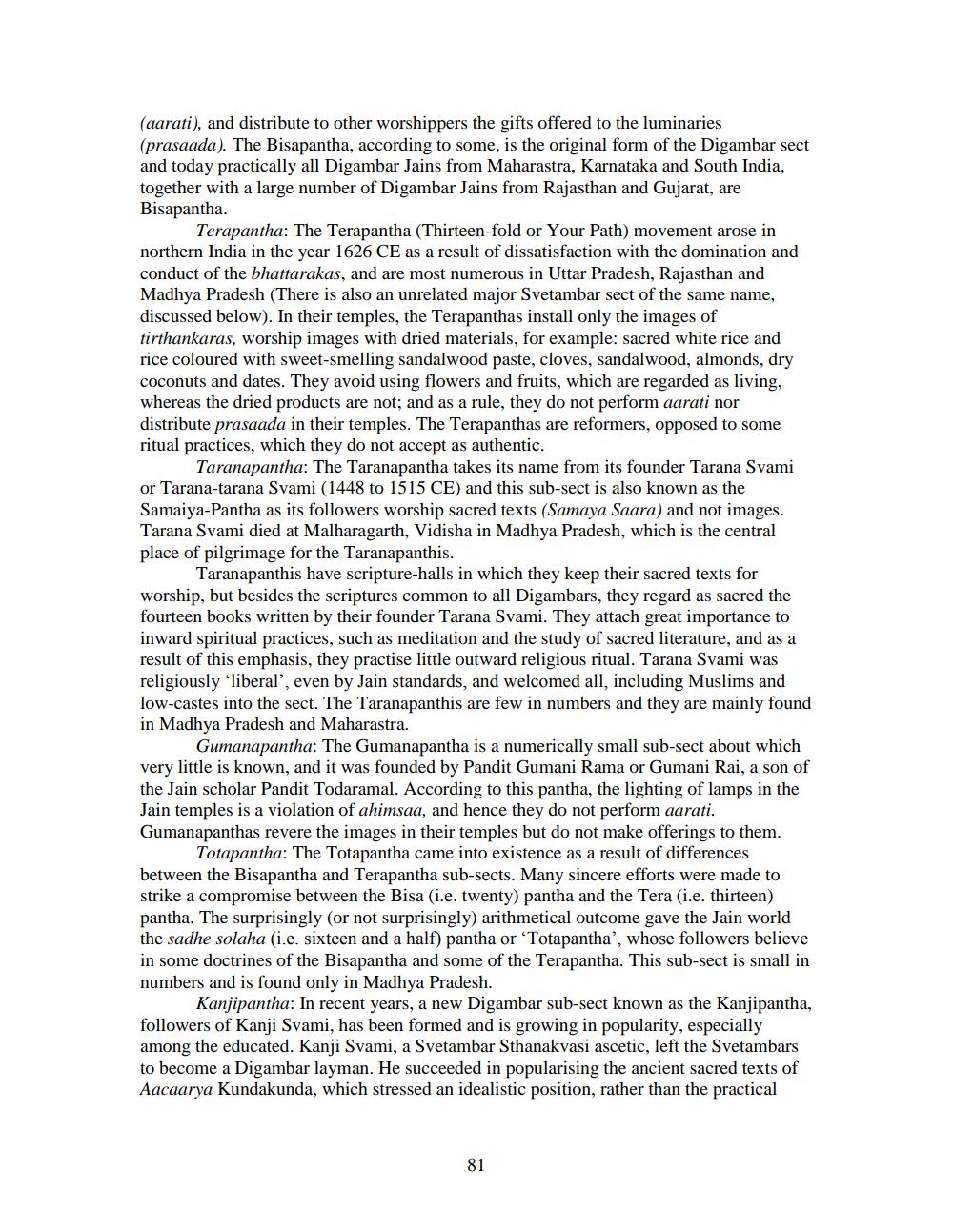________________
(aarati), and distribute to other worshippers the gifts offered to the luminaries
(prasaada). The Bisapantha, according to some, is the original form of the Digambar sect and today practically all Digambar Jains from Maharastra, Karnataka and South India, together with a large number of Digambar Jains from Rajasthan and Gujarat, are Bisapantha.
Terapantha: The Terapantha (Thirteen-fold or Your Path) movement arose in northern India in the year 1626 CE as a result of dissatisfaction with the domination and conduct of the bhattarakas, and are most numerous in Uttar Pradesh, Rajasthan and Madhya Pradesh (There is also an unrelated major Svetambar sect of the same name, discussed below). In their temples, the Terapanthas install only the images of tirthankaras, worship images with dried materials, for example: sacred white rice and rice coloured with sweet-smelling sandalwood paste, cloves, sandalwood, almonds, dry coconuts and dates. They avoid using flowers and fruits, which are regarded as living, whereas the dried products are not; and as a rule, they do not perform aarati nor distribute prasaada in their temples. The Terapanthas are reformers, opposed to some ritual practices, which they do not accept as authentic.
Taranapantha: The Taranapantha takes its name from its founder Tarana Svami or Tarana-tarana Svami (1448 to 1515 CE) and this sub-sect is also known as the Samaiya-Pantha as its followers worship sacred texts (Samaya Saara) and not images. Tarana Svami died at Malharagarth, Vidisha in Madhya Pradesh, which is the central place of pilgrimage for the Taranapanthis.
Taranapanthis have scripture-halls in which they keep their sacred texts for worship, but besides the scriptures common to all Digambars, they regard as sacred the fourteen books written by their founder Tarana Svami. They attach great importance to inward spiritual practices, such as meditation and the study of sacred literature, and as a result of this emphasis, they practise little outward religious ritual. Tarana Svami was religiously 'liberal', even by Jain standards, and welcomed all, including Muslims and low-castes into the sect. The Taranapanthis are few in numbers and they are mainly found in Madhya Pradesh and Maharastra.
Gumanapantha: The Gumanapantha is a numerically small sub-sect about which very little is known, and it was founded by Pandit Gumani Rama or Gumani Rai, a son of the Jain scholar Pandit Todaramal. According to this pantha, the lighting of lamps in the Jain temples is a violation of ahimsaa, and hence they do not perform aarati. Gumanapanthas revere the images in their temples but do not make offerings to them. Totapantha: The Totapantha came into existence as a result of differences
between the Bisapantha and Terapantha sub-sects. Many sincere efforts were made to strike a compromise between the Bisa (i.e. twenty) pantha and the Tera (i.e. thirteen) pantha. The surprisingly (or not surprisingly) arithmetical outcome gave the Jain world the sadhe solaha (i.e. sixteen and a half) pantha or 'Totapantha', whose followers believe in some doctrines of the Bisapantha and some of the Terapantha. This sub-sect is small in numbers and is found only in Madhya Pradesh.
Kanjipantha: In recent years, a new Digambar sub-sect known as the Kanjipantha, followers of Kanji Svami, has been formed and is growing in popularity, especially among the educated. Kanji Svami, a Svetambar Sthanakvasi ascetic, left the Svetambars to become a Digambar layman. He succeeded in popularising the ancient sacred texts of Aacaarya Kundakunda, which stressed an idealistic position, rather than the practical
81




